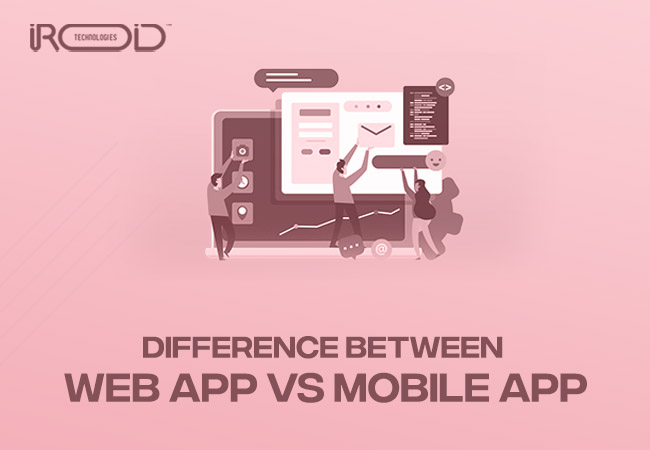Difference Between Web App Vs Mobile App

There is a common misunderstanding that native mobile apps and web apps are equivalent things — but really, the two are pretty distinct. Not only are there exceptions for the user; they are also produced and used adversely, so it’s important not to get the two blurred. Simply put, a web app is a website that is intended fluidly, reacting to being observed on a smartphone.
There are many different kinds of websites out there, few are static and are infrequently updated, while others are responsive and oughta a fabulous chance of interactivity. Web apps, notably, function like downloadable apps. But what is the disparity between a mobile app and a web app is what we take a look at in today's article.
Web app vs mobile app
Native mobile apps are created for a particular platform, such as iOS for the Apple iPhone or Android for a Samsung, or any such other device. They are downloaded and installed through an app store and have admittance to system resources, such as GPS and camera use. Mobile apps live and work on the device itself. Snapchat, Instagram, Google Maps, etc. are some examples of successful mobile apps.
Web apps, on the other hand, are obtained via the internet browser. It will adjust to whichever device you’re seeing them on. They are not native to a critical system and don’t want to be downloaded or installed. Due to their sensitive nature, they do look and function a lot like mobile apps — and this is where the ambiguity occurs.
Let’s examine the Yelp native app and. the Yelp.com web app to find what is the difference in web app vs mobile app. If you install the Yelp app on your mobile and then reach Yelp.com via the browser on your phone, you’ll see that the web app has happened to look and feel comparable to the native mobile app: it turns your browser bar, and when you scroll down, bolts the search bar in position.
While the patterns are related and follow the same fonts and color system, these are two distinct products. Web apps demand an active internet connection to operate, whereas mobile apps may operate offline. Mobile apps have the benefit of being more active and more productive, but they do want the user to frequently download updates. Whereas the web apps will update themselves.
Above all, mobile apps and web apps are sketched and built very individually. To further distinguish between the two, it serves to understand how each is formed.
How are mobile apps built?
Mobile apps are more expensive to develop compared to web apps, and because they are platform-specific, beginning an app over different platforms pretty much suggests starting from scratch in phases of design and development. However, they are much more durable and tend to be more precocious in terms of characteristics and functionality.
Native mobile apps are developed using particular languages and Integrated Development Environments (IDE) depending on the proposed platform. Apple devices work on the iOS native operating system, so Apple apps are made using either Objective-C or Swift and the Xcode IDE. Native apps for Android are composed in Java and are usually built using the Android Studio or Eclipse IDE.
Apple and Google also present their development tools, interface elements, and software development kits (SDK) which developers can apply to develop native mobile apps.
How are web apps built?
Web apps manage to be created using JavaScript, CSS, and HTML5. Unlike mobile apps, there is no official software development kit for developing web apps. However, developers do have entrance to templates. Correlated to mobile apps, web apps are normally quicker and more comfortable to build — but they are much more modest in terms of features.
Progressive web apps: the best of both?
In light of current web development trends, it’s also deserving of being aware of progressive web apps (PWA). While standard web apps need some of the functionality that mobile apps can contribute, progressive web apps fall someplace in between.
Unlike standard web apps (and also like native mobile apps), progressive web apps can work without the internet, and load remarkably quickly. This is essentially down to improvements in the refinement of the modern browser: thanks to the Application Cache feature, websites can now collect large masses of data offline. Progressive web apps can consequently be used without an internet connection, supplying them with some typical native mobile app functionalities and features such as push notifications, native video, etc.
Exactly like standard web apps, progressive web apps don’t need download or installation to be used. In many ways, they seem to offer the most beneficial of both worlds. As Alex Russell, who created the term, describes them: PWAs are “responsive, app-like, fresh, installable, linkable web experiences, safe, discoverable, re-engageable,connectivity-independent.”
Conclusion
Let us take a quick look into web app vs mobile app to summarize. Native mobile apps are quicker than web apps and have more inclusive functionality as they have admittance to system support. Also, they can work offline. However, native apps are more expensive to develop, and ensuring compatibility across different platforms often requires designing and building separate applications from scratch, whereas many successful web app examples demonstrate cost efficiency, cross-platform compatibility, and easier maintenance. Apart from that, it is expensive to maintain and update. When coming to web apps you do not need to download or install it. Alternatively, it is easy to maintain and they have a common codebase regardless of the mobile platform. The web apps will also update themselves. It is quicker and easier to build than mobile apps too. But the disadvantage is that web apps do not work offline and are slower than mobile apps, and are less advanced in terms of features. To develop web apps or mobile apps, it is suggested to have an expert by your side. Contact iROID Technologies- one of the sought after mobile app development companies in India, over a cup of coffee we can discuss what suits your business and develop it efficiently.

